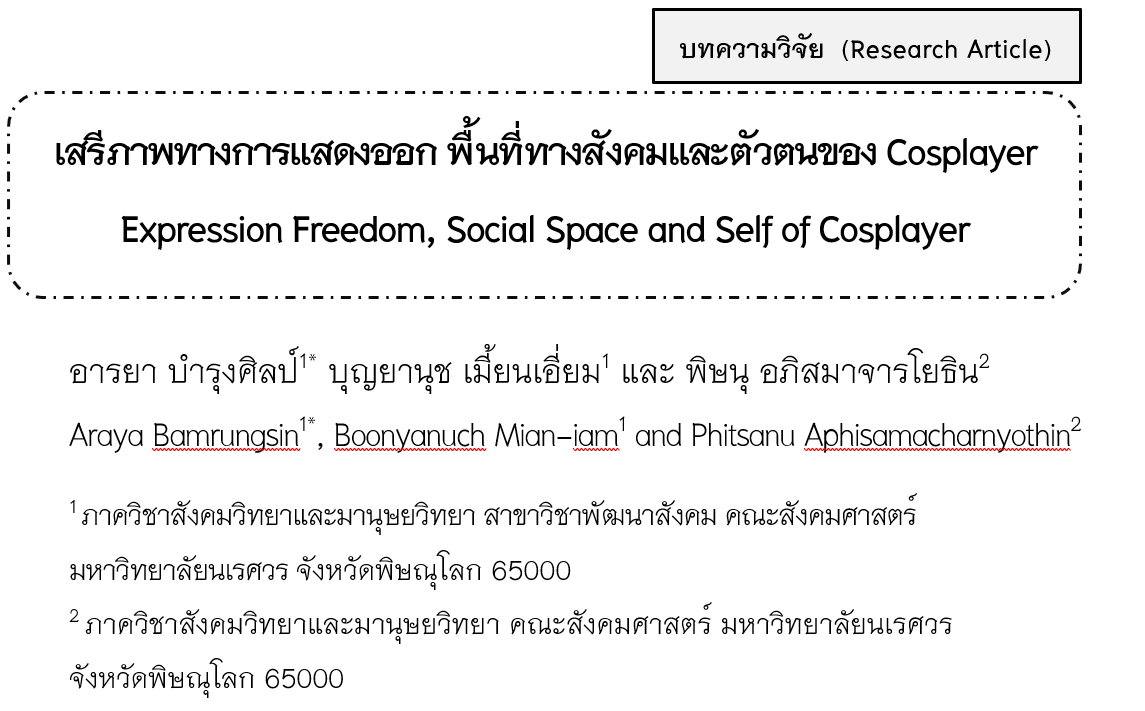Expression Freedom, Social Space and Self of Cosplayer
Keywords:
Cosplayer, Self, Expression Freedom, Social SpaceAbstract
This research aims to 1) study self-construction of cosplayer, 2) study the social space of cosplayer, 3) study expression freedom of cosplayer, 4) study challenges, barriers, and responses of the cosplayer. The key informants were 9 cosplayers. The research instrument was a semi-structured interview. The results showed that cosplayers in Muang District, Phitsanulok Province had two types of self-construction included individual Self that was as same as most people in society, and the cosplay self. That had been construation through the costumes. Therefore, the expression freedom of a cosplayer in Muang District, Phitsanulok Province had limited. As a result, the cosplayers has to find new areas to express themselves which included both real space and online space. Besides, cosplayer's freedom of expression was greater than in the past, but, it still viewed by outsiders as strange and had depression within the cosplay society. The cosplayers costume still facing with various barriers and challenges. Most of challenges come from family members and often from friends or close people. Therefore, the cosplayer group had to deal with these barriers and challenges.
References
กอบชัย ศักดาวงศ์ศิวิมล. (2552). การสื่อสารเพื่อการสร้างพื้นที่สาธารณะของวัฒนธรรมย่อย Cos’Play. (วิทยานิพนธ์ปริญญานิเทศศาสตรมหาบัณฑิต). กรุงเทพฯ: จุฬาลงกรณ์มหาวิทยาลัย.
ฎูริณัฐร์ โชติวรรณ. (2557). กะเทยโรงงาน : ชีวิตและตัวตนข้ามเพศของแรงงานอพยพจากภาคตะวันออกเฉียงเหนือ. (วิทยานิพนธ์ปริญญาศิลปศาสตรมหาบัณฑิต)เชียงใหม่: มหาวิทยาลัยเชียงใหม่.
ธวัชพงศ์ หาเรือนโภค. (2557). Cosplay: วัฒนธรรมป๊อปของวัยรุ่นในสังคมไทย.(วิทยานิพนธ์สังคมวิทยาและมานุษยวิทยามหาบัณฑิต). กรุงเทพฯ: มหาวิทยาลัยธรรมศาสตร์.
เบญจมาศ ยศพิทักษ์. (2553). การสื่อสารกลุ่มแรงจูงใจในการแต่งกายคอสเพลย์ของวัยรุ่นไทย. (วิทยานิพนธ์ปริญญาศิลปะศาสตรมหาบัณฑิต). กรุงเทพฯ: มหาวิทยาลัยมหิดล.
รัชนก พุทธสุขา. (2562). ทำความรู้จักกลุ่ม Cosplay ในสังคมไทย ผู้เลือกรับ Japanese pop culture. สืบค้น 5 ธันวาคม 2563, จาก https://www.museumsiam.org/da-detail2.php?MID=3&CID=177&SCID=242&CONID=3188.
รุ้งนภา ยรรยงเกษมสุข. (ม.ป.ป.). ทฤษฎีปฏิสัมพันธ์เชิงสัญลักษณ์กับการอธิบายปรากฏการณ์สังคมจากมุมมองตัวแสดง Symbolic Interaction Theory and the Explanation of Social Phenomena from Actor Perspective. วารสารการเมือง การบนิหาร และกฎหมาย, 5(2), 77-80.
รัตติกานต์ วิไลพันธ์ และพิษนุ อภิสมาจารโยธิน. (2562). การประกอบสร้างตัวตนทางเพศ และพื้นที่ทางสังคมของกลุ่มแฟนคลับศิลปินเกาหลีใต้: กรณีศึกษากลุ่มวัยรุ่นไทยในกรุงเทพมหานคร. ใน นเรศวรวิจัย ครั้งที่ 13. พิษณุโลก: มหาวิทยาลัยนเรศวร.

Downloads
Published
How to Cite
Issue
Section
License
Copyright (c) 2022 Phayao University

This work is licensed under a Creative Commons Attribution-NonCommercial-NoDerivatives 4.0 International License.
ผู้นิพนธ์ต้องรับผิดชอบข้อความในบทนิพนธ์ของตน มหาวิทยาลัยพะเยาไม่จำเป็นต้องเห็นด้วยกับบทความที่ตีพิมพ์เสมอไป ผู้สนใจสามารถคัดลอก และนำไปใช้ได้ แต่จะต้องขออนุมัติเจ้าของ และได้รับการอนุมัติเป็นลายลักษณ์อักษรก่อน พร้อมกับมีการอ้างอิงและกล่าวคำขอบคุณให้ถูกต้องด้วย
The authors are themselves responsible for their contents. Signed articles may not always reflect the opinion of University of Phayao. The articles can be reproduced and reprinted, provided that permission is given by the authors and acknowledgement must be given.







